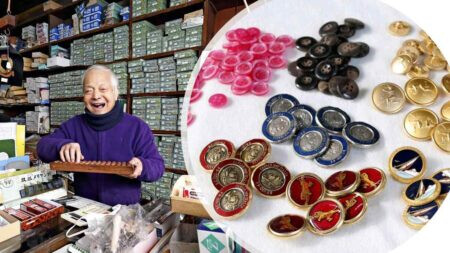
Just a short walk south of JR Akihabara Station, nestled along the Yanagihara-dori street bordering the Kanda River, stands a remarkable building, a relic of 1928. Okasho Uraji Botan Ten, a fabric and button store that also serves as a residence, commands attention with its copper-plated façade and distinctive design.
This structure is a prime example of "kanban kenchiku," or "billboard architecture," a style popular during the reconstruction period following the devastating Great Kanto Earthquake of 1923. While rare today, this architectural approach, where buildings are designed to resemble billboards, was once a common sight. Okasho Uraji Botan Ten's unique charm has garnered significant attention, even attracting interest as a potential film location.
Inside the store, a treasure trove of specialized materials for men's clothing awaits. Buttons, spools of thread, and other notions, some long out of production, line the shelves. "Many customers travel from distant places like Chiba and Saitama prefectures to find items they can't get elsewhere," explains Takeo Oka, the 80-year-old owner.
Yanagihara-dori street boasts a rich history, believed to have been a hub for stalls since the Edo period (1603-1867), earning it the moniker "used clothing town." Oka's grandfather established a secondhand clothing shop there in 1897, during the Meiji era (1868-1912). The Great Kanto Earthquake severely damaged the building, prompting its reconstruction in a fire-resistant "billboard architecture" style.
The street gradually transformed into a "clothing town," with custom-made suits reaching peak popularity after World War II. "Back then, a custom-made suit was a rite of passage, a symbol of joining society," Oka recalls. This boom led to the establishment of numerous tailor shops and material stores, prompting Oka's store to specialize in buttons and threads.
The rise of affordable, ready-made clothing led to a decline in tailor shops. However, Oka, who has worked in the store since his youth, never considered another career. He took over the business from his father in his 60s and continues to run the small shop, serving a handful of customers each day.
Oka spends his days watching TV in the shop, sourcing goods, and greeting visitors with a warm smile. He has become an integral part of the local community. "I enjoy this business because it allows me to interact with all sorts of people in the town where I was born and raised," he says. He plans to continue the business for as long as he is able, a living testament to tradition and a unique piece of Tokyo's architectural heritage.
[Copyright (c) Global Economic Times. All Rights Reserved.]






























